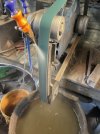After making ten thousand knives on 2" grinders, upon returning from vacation I'm having one of those moments.....
Why are 2" grinders the standard?
I've actually never ground a blade on a wider belt or a large water cooled rotary stone, but as my standards for knives have gone up over the years I'm more and more aware of the drawbacks of using a relatively narrow belt, and the videos I've seen of English, Japanese, and industrial grinding are inspiring me to rethink the whole process as it has been.
Anyone out there using something in the 4+ range? If so, what are your thoughts, if you have experience on the 2x72 as well?
Why are 2" grinders the standard?
I've actually never ground a blade on a wider belt or a large water cooled rotary stone, but as my standards for knives have gone up over the years I'm more and more aware of the drawbacks of using a relatively narrow belt, and the videos I've seen of English, Japanese, and industrial grinding are inspiring me to rethink the whole process as it has been.
Anyone out there using something in the 4+ range? If so, what are your thoughts, if you have experience on the 2x72 as well?





